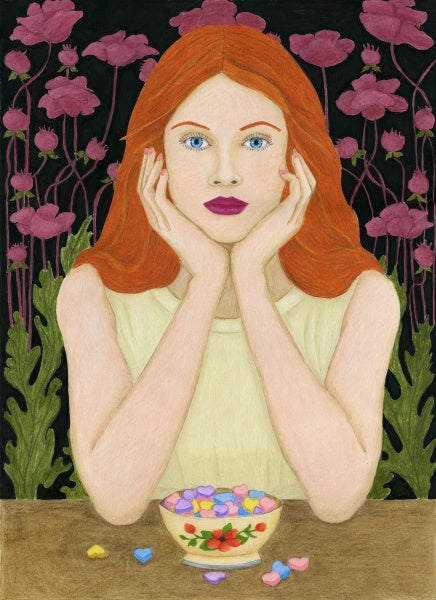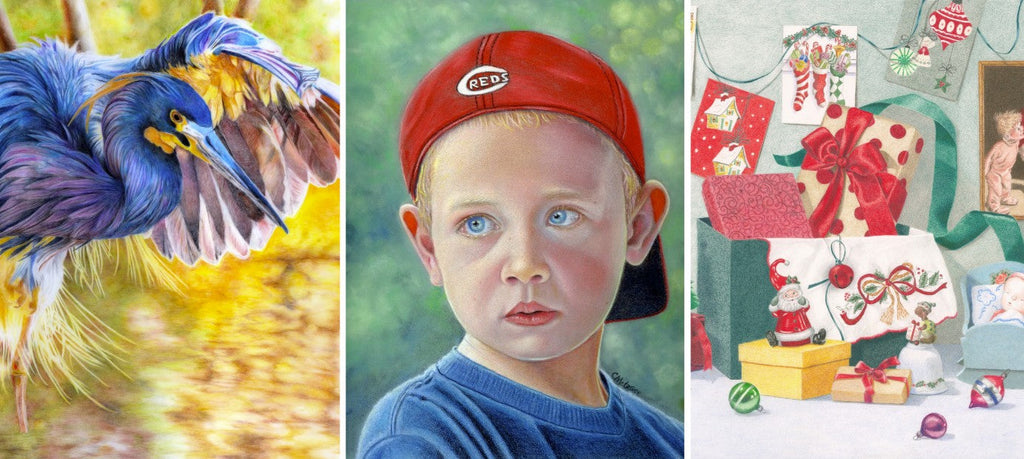My Love of Botanical Art and Colored Pencils
by Melinda Edstein

'Monkey Cups'. To be included in the Hunt Institute's 16th International Exhibition.
I was fortunate to grow up on a large suburban block on the outskirts of Sydney, where my mother was a passionate and talented gardener. My sisters, neighbors and I played in our backyard – sucking sweet nectar from prawn plant flowers, making paper from papyrus, and mixing ‘cakes’ from cotoneaster berries (luckily we didn’t actually eat these poisonous morsels).
Our father was an expert fisherman, and most of our family day trips and holidays revolved around beaches and rivers or camping next to mountain streams.
I think we all grew up with an appreciation of plants, animals and nature.
I enjoyed art at school and took it as a subject until I was fifteen. I then swapped to economics. This was partly because I found the art history dates and names rather overwhelming, and partly because my father insisted I take a “real” subject.
Science was my favorite area of study, especially biology. I am grateful that we had a very good, very strict science teacher. She insisted that every beaker of liquid was drawn with the correct meniscus, every bunsen was drawn correctly, and every cell, plant, animal, or geological formation was depicted accurately. Upon reflection, I think much of my love of science was actually my love of drawing.

Detail of 'Kangaroo Paw'. Australian flowers can be extremely complex and difficult to draw.
At the University of Sydney I gained a Bachelor of Veterinary Science, Hons 1. My only dabble in art during that time was in histology classes, copying cell structures from electron micrographs. I did find that my drawings were quite popular with classmates who weren’t so inclined. I then worked as a small animal veterinarian for 16 years.
My husband, four children and I settled in a big old house, with a big old garden, in Strathfield, Sydney. During this time my only opportunities to draw were to create posters for fetes and to ‘help’ with school projects.
As our youngest children were finishing school and I was no longer working, I started looking for new challenges. I had never felt creatively free enough to try more abstract types of art, and I had no formal art training. Botanic art seemed to be the perfect choice. I could combine my interest in science and gardening with a renewed study of drawing.
In 2008 I enrolled in botanic art classes at the Royal Botanic Gardens, Sydney. These stunning gardens overlook the iconic waters of Sydney Harbour. Such an inspiring place to appreciate the beauty of plants.
Initially, I worked in watercolors, the traditional medium used in botanic art. I was happy with what I produced, but I did struggle a little with the free-flowing watercolors. My teacher suggested I try using colored pencils. I have never looked back.
In 2017 I completed the Society of Botanical Artists (SBA) distance learning course from London, gaining a Diploma with Distinction. I have exhibited at Botanica, (Royal Botanic Gardens, Sydney), since 2010, and also in Melbourne, Canberra, and in the Society of Botanical Artists exhibit in London. I was fortunate to have two of my pieces selected in the Australian section of this year’s Botanical Art Worldwide Exhibition. One of my pieces, ‘Monkey Cups’, will be part of the 16th International Exhibition of Botanical Art and Illustration 2019. It is held every three years at the Hunt Institute of Botanical Documentation in Pittsburgh, USA.

'Gourd'. Sometimes a simple vegetable can make an interesting subject.
Botanical art has quite strict guidelines. It should provide scientifically correct information about the plant, whist placing high importance on aesthetics.
Botanical art is traditionally done to scale, on a white background. Contemporary artists are challenging these practices, as well as experimenting with new ideas in composition.
Drawings are best done mainly from live specimens. This presents the challenge of capturing the image before the plant grows, wilts, blooms or fades. Dried specimens can be used as an aid if the plant is out of season. Photos can be used to help, but they can’t convey the detail of a live specimen.
I still have a lot to explore in both colored pencils and botanic art. I tend to stick with mainly Faber Castell Polychromos oil-based pencils, and my technique is largely self-taught. I’d like to experiment with using more of the softer, wax based pencils such as Prismacolor and Caran d’Ache, which give a smoother finish, but less detail. I have a small stockpile of Schoellershammer 4G paper, which is very smooth. It enables me to do fine line work, but still accepts quite a lot of color (I tend to be rather heavy handed).
I have a lovely little art room overlooking the magnolia, bauhinia, and jacaranda trees in our front yard. It’s a good place to become lost in the complex and challenging structure of Australian flowers, as well as exotics, fruit, and vegetables.
Botanical art is a wonderful way to combine art, science, and nature. It can portray depth and detail not necessarily visible in photography. Each study conveys an intimate knowledge of the subject, encouraging people to appreciate the wonders of the simplest leaf to the most complex flower.
About Melinda:

Melinda lives in Sydney, Australia. She took up botanical art and colored pencils in 2008, and has since exhibited locally and internationally. Melinda holds a Diploma with Distinction from the Society of Botanical Artists, London, and is a signature member of the Coloured Pencil Community of Australasia.
See more from Melinda: https://melindaedsteinart.com/





Comments (2)
Hi , am coming back to pencil illustration f butterflies and botanicals after a few years, am not able to locate Shoellschammer 4g in Australia, I used to buy it as a board, am wondering your view of Fabriano artistico hp as an alternative if you might be familiar?
Anna Robertson - Nov 15, 2018Regards
Anna Robertson
Gladstone, Queensland
Congratulations on your accomplishments! I was curious, as a newer colored pencil person, what Polychromos color would you say most closely resembles the traditional “botanical grey”? Thank you.
Janelle - Nov 15, 2018